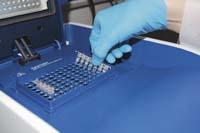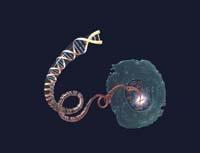Variability as a source of information

The genome allows to know who each one is; it allows to put name and surname to the living. Identification can be performed at different scales. Returning to the smaller scale, we can descend to the individual level. Those who work on this scale are able to detect the difference between two people and, for example, know who has been the murderer of a murder, as in forensic investigations that are now so fashionable on television.
Sometimes they work on a larger scale and make more general identifications. For example, in the food industry it has been published on more than one occasion the disappointment of such establishments and the non-marketing of the product.
These frauds occur mainly in foods that sell processed: minced meat, fish or pate in canned canned, cheeses... In these cases it is not possible to know at first sight which animal come from these foods, since they have lost all the visible characteristics that characterize them before reaching the buyer. The DNA analysis of this product allows to determine the species to which a particular product belongs.
Comparison is the key
The use given to it, the analysis of the scale they want to study, and for this they use the technique they use, scientists are based on one thing when analyzing the variation of DNA: comparison.

They always start from a sample; in a forensic investigation it can be a hair and in a food safety investigation, a piece of pate of a canned canister. To draw conclusions from these samples, they must be compared with some reference.
To find out who the hair found in the place of a murder belongs, which is what allows him to attribute to that specific person his presence in the place of the murder, he compares it with the DNA of the suspects. In the same way, to know what animal the canned pate is, they take a piece of meat from that can and compare it with all possible species.
Yes, but what do they compare? The human genome, for example, has 3,000 million nucleotides. Complete comparison of genomes would not be feasible. Instead, scientists agree on which part of the genome they have to look for everything they want to know. The parts they choose include the variability they are looking for, which considerably limits the work to be done.
To analyze any part of the DNA, you must first make that part visible. In fact, in order to detect the tools and techniques they currently use, DNA must be present in very high quantities, requiring millions of copies of DNA.
Therefore, the first step is to expand the part to be analyzed. This proliferation is known as amplification, using techniques, polymerase chain reactions or PCR. The PCR allows millions of copies of a fragment of DNA. Since scientists have agreed which regions should be studied from the genome to know one or another information, only these are the ones that multiply.

Seeking individuality
When the goal is to separate an individual from the rest of individuals of his species, that is, when they want to carry out an individual identification, scientists must resort to characteristics that make oneself unrepeatable. At first glance it does not seem a very simple task, since individuals of a certain species share much of the genome; in the human species, for example, 99.9% of the genome is equal in all humans.
Although the remaining percentage is low, the number of nucleotides is not at all negligible. Given that the human genome has 3,000 million nucleotides, the difference between one man and another can be in three million nucleotides.
In addition, not all the genome has the same rate of variability, some regions are more variable than others. In these cases we should look at those who are very variable, since there will be more possibilities to find differences in these regions.
For example, small sequences of 2-4 nucleotides are repeated several times in a row and the number of copies is very variable from one individual to another. Microsatellites are those parts of the genome that have a small repeat sequence.

It is normal for a population to appear between 6 and 8 alleles or versions of a certain microsatellite. The study of several microsatellites allows to determine the suspect of the hair found in the place of a murder. In short, as these regions are so changing, there is very little chance that the microsatellite of DNA present in the hair is the same as that of the DNA of a person who is not the owner of the hair.
The study is based on another characteristic common to microsatellites: genome stability at both ends. Therefore, this is very useful for performing the aforementioned PCR. Putting as first or 'initiator' a part that is associated with this stable sequence, they get the amplified part to be only microsatellite.
Then, once the part of the genome that interests them has been amplified, the time comes for comparison. They use the technique called electrophoresis. All microsatellites that study move in a porous gel (the hair and suspects). Porous gel hinders the movement of the piece of DNA: the longer a microsatellite is, the less travel in the classroom. Likewise, its greater length implies that the sequence of 2-4 nucleotides appears more often. Thus they discover the size of each microsatellite. To find out who the killer is, the microsatellites that are suspected are the same size as the microsatellites taken from the hair.
The latest for individual identification
The most widely used method for individual identification is that of microsatellites. In recent times, however, scientists are increasingly likely to abandon microsatellites to use so-called mononucleotide polymorphism or SNP. It has many advantages over microsatellites.

Differences in a nucleotide are much more abundant in the genome than microsatellites. In the case of humans, for example, there is a SNP every three hundred nucleotides.
Many SNPs can also be detected simultaneously. In the case of microsatellites, the processing temperature of the PCR and other conditions must be very precise to detect each microsatellite.
There are several methods to find SNPs, but they all have the same goal: to determine which nucleotide is at a particular point. One, for example, is based on hybridization.
In the case of hybridization, specific probes are used. Probes are sequences that are associated with the searched SNP and adjacent nucleotides. Normally, in places where SNPs appear there is usually the possibility that only two nucleotides appear (in fact, there should be the possibility that four nucleotides appear, but for some reason only two).
Therefore, once the region to be studied has been amplified, two probes are introduced to see what is associated with the part of DNA being studied. The probes are marked in some way in order to separate them. For example, if they are marked with fluorescence, they put different colors to the probes, and thus they know in color which of the two probes has joined the sample and, therefore, which nucleotide is the content in that SNP.

Species differentiation
Individual identification is not always useful. When the goal is to ensure that the content of a can of pates is of this species, nothing serves the variability that there is from one individual to another.
In these cases, other regions of the genome are analyzed. These regions must be variable enough to be different from one species to another, but they must be stable to be equal in all individuals within the same species.
The genome of these characteristics is not sought by scientists in the cell nucleus, but in cellular mitochondria. Mitochondria have their own DNA. The speed of variation of this DNA is suitable for use as a separator between species.
In addition, it is much more abundant than the genome of the nucleus. Each mitochondria has several copies of DNA and each cell has several mitochondria.

The most commonly used technique for species separation is PCR-FINS. This technique is based on sequencing. They take an individual from each species and sequence a fragment of a certain region of mitochondrial DNA (a region that encodes part of the enzyme c cytochrome oxidase). In this way a large database has been created that indicates the sequence of each species in this region.
You just have to catch a piece of meat from the pate can that is being studied and sequence the region to know what animal meat that pate has made.
The study of genome change has eleven other applications. These are just two examples. However, they are sufficient to warn that information stored in all your cells is the most reliable ID.





